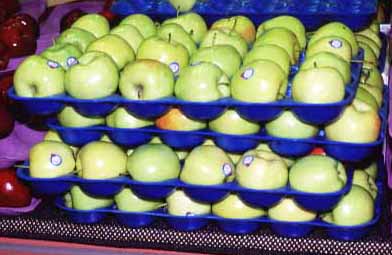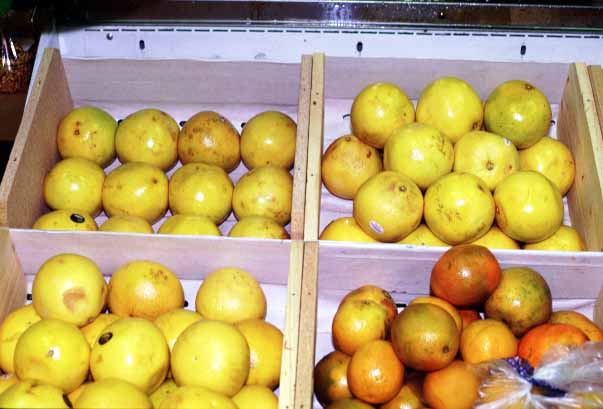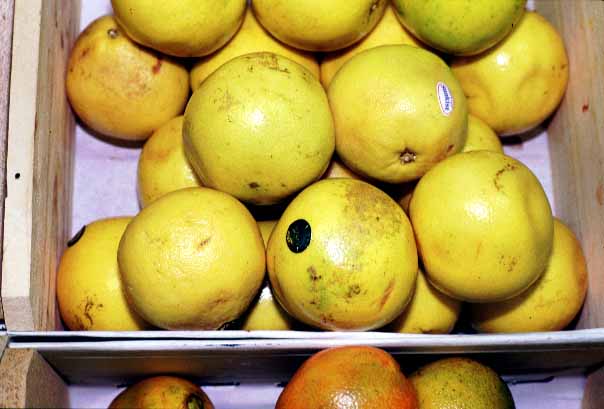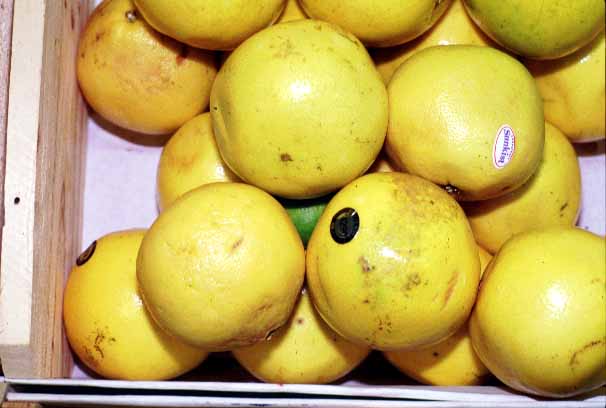Day 10
Atomic Packing Arrangements
Anions are generally larger than cations, and the outer
orbitals of electrons about most anions are s-orbitals. For these reasons,
it is convenient to describe and view many atomic structures as consisting
of identical spheres packed in some arrangement.
There are many examples in nature and the world around
us where similar objects pack and arrange to fill a particular volume.
One trip through a grocery store illustrates some simple packing schemes
of atoms.
 Simple
Cubic Packing, or 'Body Centered Cubic Packing', results when each layer
of atoms has a regular, square lattice arrangement. Alternate layers are
translated along a body diagonal (see the body-centered isometric lattice,
Fig. 3.17-13, p. 126).
Simple
Cubic Packing, or 'Body Centered Cubic Packing', results when each layer
of atoms has a regular, square lattice arrangement. Alternate layers are
translated along a body diagonal (see the body-centered isometric lattice,
Fig. 3.17-13, p. 126).
 Closest
packing structures result when layers of atoms are arranged in a hexagonal
pattern. In closest packing arrangements, each atom ( or grapefruit, in
the upper right box) is in closest-contact with six others in the
layer. (Imagine that each layer extends indefinitely, and count how many
grapefruit are arranged about each individual fruit). Closest packing arrangements
lead to higher density structures, as the spaces between atoms are smaller.
Closest
packing structures result when layers of atoms are arranged in a hexagonal
pattern. In closest packing arrangements, each atom ( or grapefruit, in
the upper right box) is in closest-contact with six others in the
layer. (Imagine that each layer extends indefinitely, and count how many
grapefruit are arranged about each individual fruit). Closest packing arrangements
lead to higher density structures, as the spaces between atoms are smaller.
 There are two closest packing arrangements - Cubic Closest
Packing (CCP) and Hexagonal Closest Packing (HCP). In hexagonal closest
packing, every other layer is identical, and thus the upward 'repeat' of
layers in a structure is ABABABAB.... (As in the two layers at left).
There are two closest packing arrangements - Cubic Closest
Packing (CCP) and Hexagonal Closest Packing (HCP). In hexagonal closest
packing, every other layer is identical, and thus the upward 'repeat' of
layers in a structure is ABABABAB.... (As in the two layers at left).
In cubic closest packing, it is every third layer that
is identical, and thus the repeat is ABCABCABCABC.... Considering the stacks
of grapefruit above, the third layer would come into a position different
than the first two.
In both HCP and CCP, each sphere is in contact with tweleve
others in the three-dimensional structure.
 The arrangements of spaces, or voids, in HCP and CCP is fundamentally
different. You can see the spaces by comparing the figure above with the
one at the left. A space with six corners is empty above, and filled by
a Key lime, at left. This is an octahedral
void in the closest-packing arrangement of grapefruit, and the lime is
octahedrally coordinated with respect to the surrounding grapefruit.
The arrangements of spaces, or voids, in HCP and CCP is fundamentally
different. You can see the spaces by comparing the figure above with the
one at the left. A space with six corners is empty above, and filled by
a Key lime, at left. This is an octahedral
void in the closest-packing arrangement of grapefruit, and the lime is
octahedrally coordinated with respect to the surrounding grapefruit.
Tetrahedral voids, those
with four corners and which are smaller, are also are present throughout
the structure. In the photos above, each grapefruit sits on top of three
in the layer below, thus surrounding a space with four corners. (Herein
lies another way to 'see' differences between octahedral and tetrahedral
sites, viewed from above - you can see the octahedral sites, but the tetrahedral
ones are 'hidden' by the top layer.)
The Key lime above would not fit into one of the tetrahedral
sites. However, a smaller round fruit (maybe a muscadine grape) would fit
into a tetrahedral site. Thus the sizes of voids is dependent on the number
of atoms arranged around the void. Similarly, the size of speres that can
be placed into the void depends on the relative size of the void. Therefore,
polyhedra of higher coordination number accomodate larger atoms, as indicated
in the table below.
| CN |
RR |
Type |
Polyhedra/Form |
| 2 |
<.155 |
Linear |
Line |
| 3 |
.155 |
Triangular |
Triangle |
| 4 |
.255 |
Tetrahedral |
Tetrahedron |
| 6 |
.414 |
Octahedral |
Octahedron |
| 8 |
.732 |
Cubic |
Cube |
| 12 |
1.0 |
Cuboctahedral |
Cuboctahedron |
Oxygen is, by far and by any measure, Earth's most abundant
atom. Therefore, when considering values of radius ratio and the way cations
fill atomic structures, it is most important to consider the radius ratio
of cations to oxygen. Table 4.9 in the text tabulates the radius ratio
and typical CN for various cations and oxygen.
Not all of the possible sites in an atomic structure will,
necessarily, be filled. In order for a mineral to be stable, the total
number of ions must be such that the whole structure is electrically neutral.
Local Charge Balance: CaF2, CN=8. Ca+2, 8 F at -1/4 each
(cubic coordination). Work out examples for SiO4 (tetrahedral coordination),
and CO3 (in triangular coordination).
Pauling's
Rules:
| Rule #1 |
A coordinated polyhedron of anions is formed about each
cation, the cation-anion distance equaling the sum of their characteristic
packing radii and the coordination polyhedron being determined by the radius
ratio. |
| Rule #2 |
An ionic structure will be stable to the extent that
the sum of the strengths of the electrostatic bonds that reach an ion equal
the charge on that ion. |
| Rule #3 |
The sharing of edges, and particularly faces, by two
anion polyhedra decreases the stability of the ionic structure. |
| Rule #4 |
In a crystal containing different cations, those with
high valency and small coordination number tend not to share polyhedron
elements with one another. |
| Rule #5 |
The number of essentially different kinds of constituents
in a crystal tends to be small. |



 Simple
Cubic Packing, or 'Body Centered Cubic Packing', results when each layer
of atoms has a regular, square lattice arrangement. Alternate layers are
translated along a body diagonal (see the body-centered isometric lattice,
Fig. 3.17-13, p. 126).
Simple
Cubic Packing, or 'Body Centered Cubic Packing', results when each layer
of atoms has a regular, square lattice arrangement. Alternate layers are
translated along a body diagonal (see the body-centered isometric lattice,
Fig. 3.17-13, p. 126). Closest
packing structures result when layers of atoms are arranged in a hexagonal
pattern. In closest packing arrangements, each atom ( or grapefruit, in
the upper right box) is in closest-contact with six others in the
layer. (Imagine that each layer extends indefinitely, and count how many
grapefruit are arranged about each individual fruit). Closest packing arrangements
lead to higher density structures, as the spaces between atoms are smaller.
Closest
packing structures result when layers of atoms are arranged in a hexagonal
pattern. In closest packing arrangements, each atom ( or grapefruit, in
the upper right box) is in closest-contact with six others in the
layer. (Imagine that each layer extends indefinitely, and count how many
grapefruit are arranged about each individual fruit). Closest packing arrangements
lead to higher density structures, as the spaces between atoms are smaller.
 There are two closest packing arrangements - Cubic Closest
Packing (CCP) and Hexagonal Closest Packing (HCP). In hexagonal closest
packing, every other layer is identical, and thus the upward 'repeat' of
layers in a structure is ABABABAB.... (As in the two layers at left).
There are two closest packing arrangements - Cubic Closest
Packing (CCP) and Hexagonal Closest Packing (HCP). In hexagonal closest
packing, every other layer is identical, and thus the upward 'repeat' of
layers in a structure is ABABABAB.... (As in the two layers at left).  The arrangements of spaces, or voids, in HCP and CCP is fundamentally
different. You can see the spaces by comparing the figure above with the
one at the left. A space with six corners is empty above, and filled by
a Key lime, at left. This is an octahedral
void in the closest-packing arrangement of grapefruit, and the lime is
octahedrally coordinated with respect to the surrounding grapefruit.
The arrangements of spaces, or voids, in HCP and CCP is fundamentally
different. You can see the spaces by comparing the figure above with the
one at the left. A space with six corners is empty above, and filled by
a Key lime, at left. This is an octahedral
void in the closest-packing arrangement of grapefruit, and the lime is
octahedrally coordinated with respect to the surrounding grapefruit.